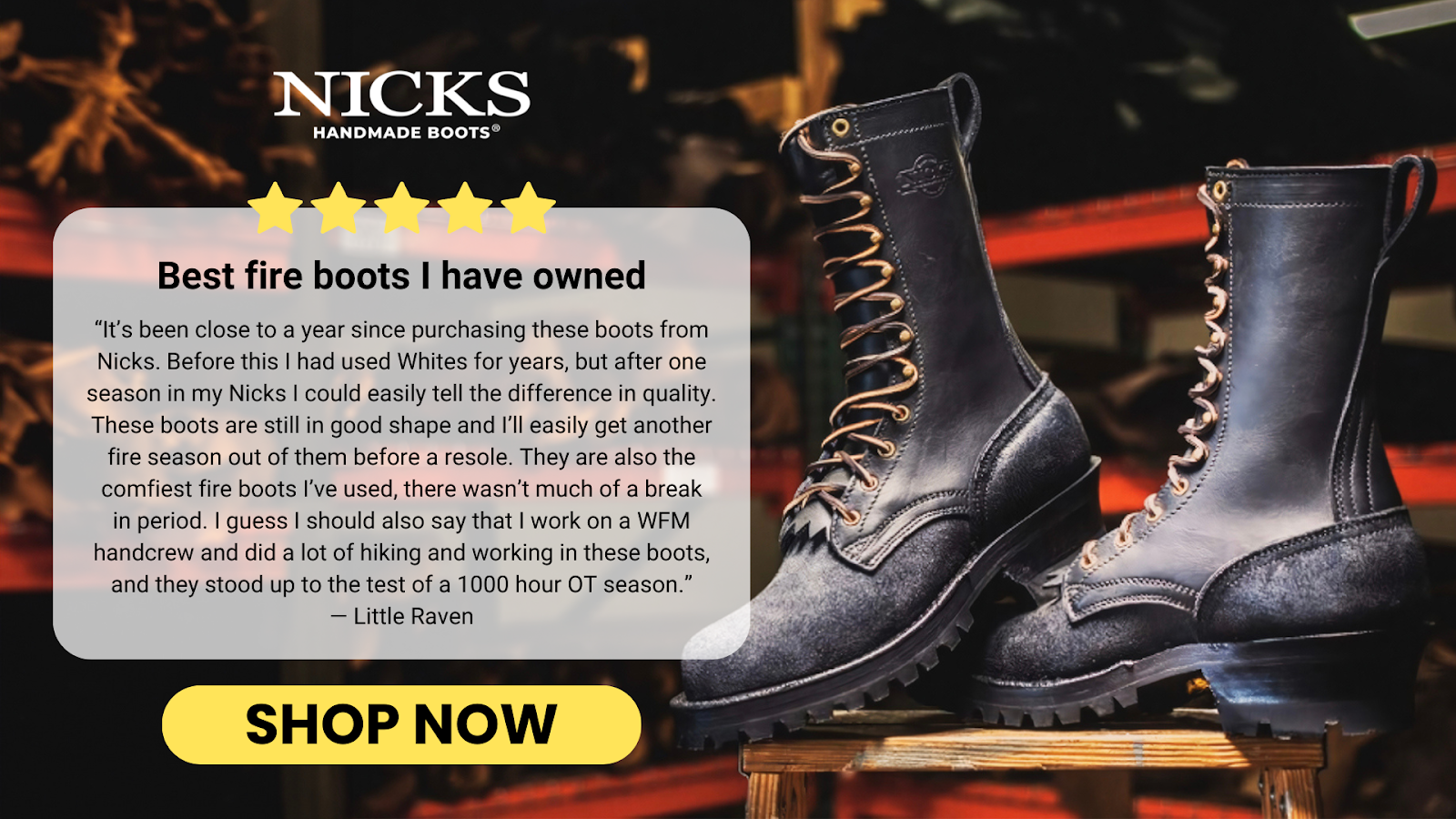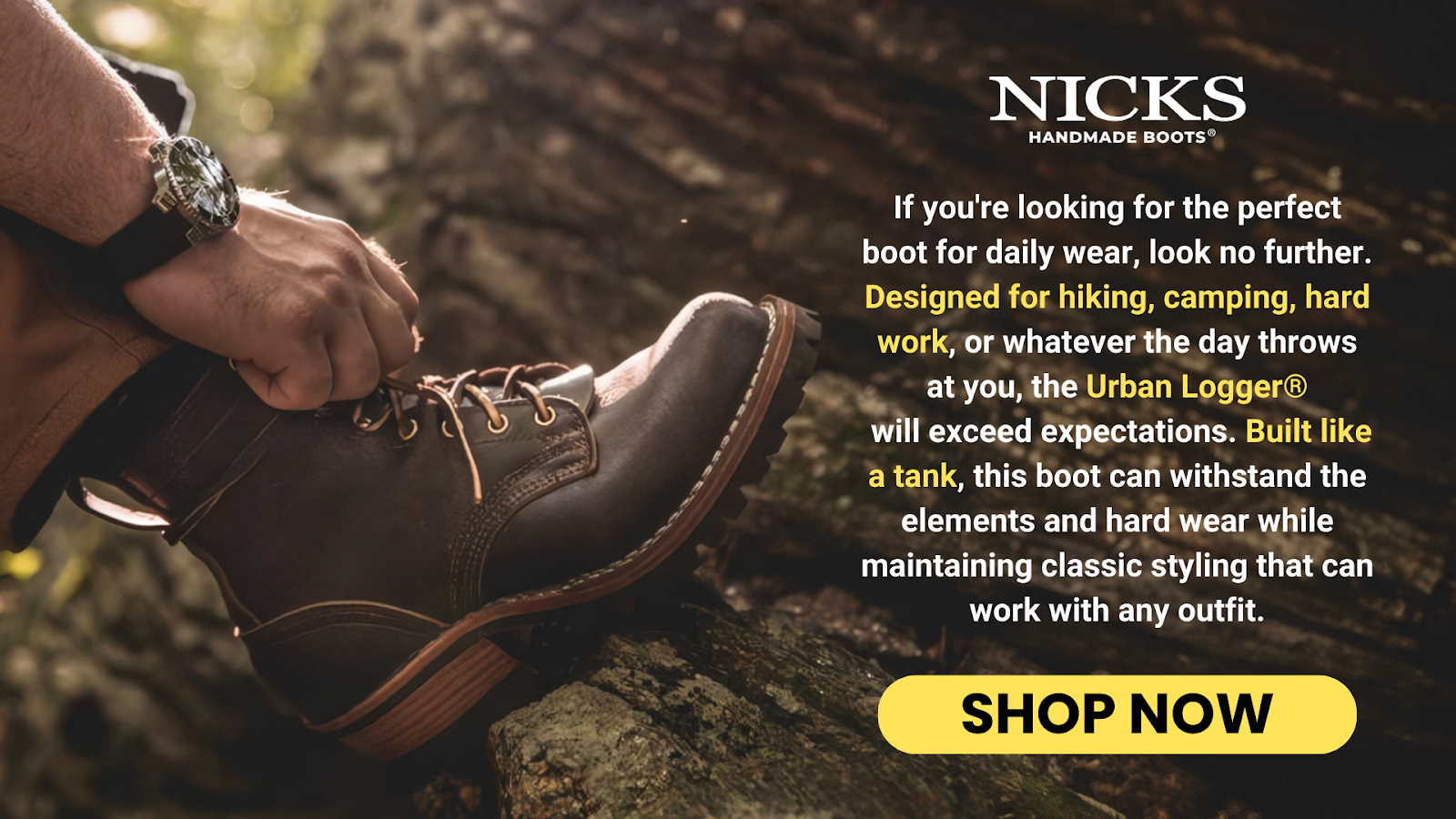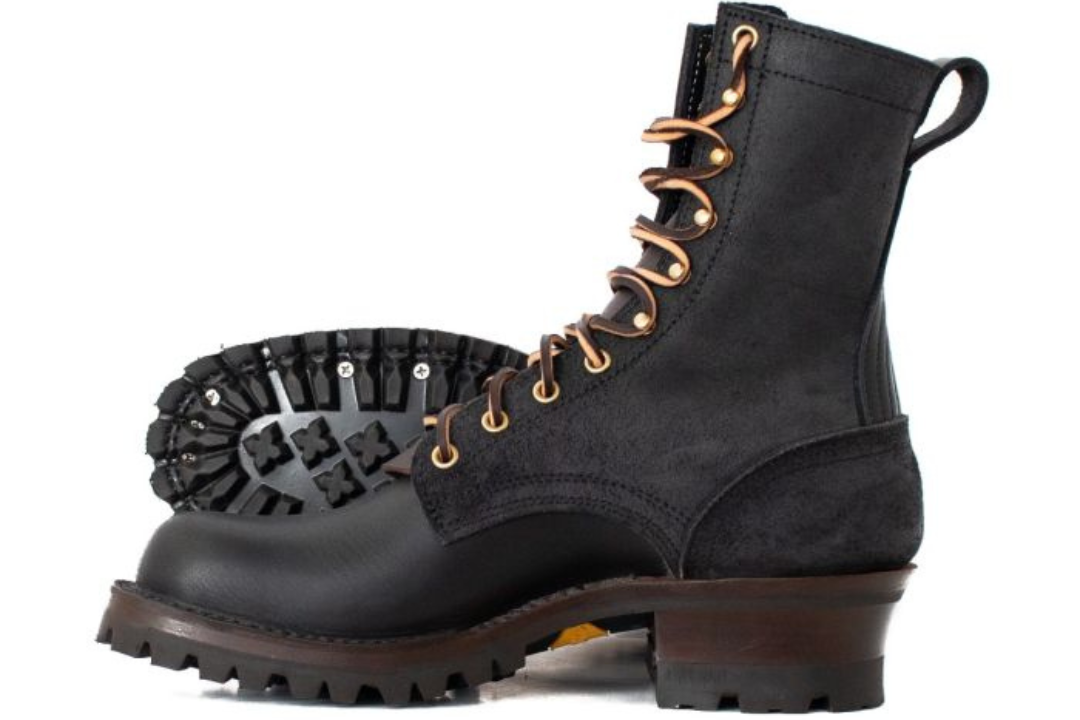Key Takeaways:
- Measurement Precision: Accurately measuring both the length and width of your feet is critical to selecting the right boot size, ensuring comfort and preventing foot problems.
- Material Considerations: The choice of materials affects both the durability and comfort of boots, with options like leather adapting to the foot's shape over time.
- Sizing Standards Variance: Understanding the differences between US, UK, and EU size charts is essential for choosing boots that fit well, especially when ordering from international brands.
At Nicks Boots, we specialize in crafting boots that are both durable and stylish, designed to endure over time. As industry leaders, we understand that the secret to an outstanding boot experience lies in finding the perfect fit. Selecting the correct boot size is essential for comfort, performance, durability, and support with every step.
Finding the perfect fit is crucial when it comes to choosing the right pair of boots, and we understand that navigating boot sizes can sometimes be a confusing task. Whether you're shopping for rugged work boots or stylish weekend wear, our size chart is designed to guide you through finding the ideal fit based on accurate measurements. Read on to discover how you can measure your feet at home and compare your findings with our
This piece will walk you through the basics of boot size charts, demonstrate how to measure your foot's length and width accurately, and show how these measurements relate to the perfect boot size for both work and leisure. We'll explore different sizing standards from various regions (US, UK, EU), and highlight the significance of tailoring your selection based on the style and materials of the boot.

Understanding Boot Size Charts: Length And Width Essentials
Length Measurement
The process of measuring your foot length is straightforward but crucial for a precise fit. Start by placing your foot flat on a blank piece of paper, ensuring your full weight is on the foot to expand it to its natural size. Draw a line at the heel and the longest toe—remember, this might not always be the big toe. Use a ruler to measure the distance between these lines either in inches or centimeters, which you can find on any standard measuring tape. This length should be used to find your size on our boot size chart.
Width Measurement
Width measurement is vital for comfort and to prevent blisters or discomfort. After measuring the length, use a soft measuring tape to capture the circumference of the widest part of your foot. Keep the tape firm but not tight to get an accurate reading. Compare this measurement against the width options available in our boot size chart. Proper width ensures that the boot will not pinch or feel too loose, maintaining stability and comfort.
How To Measure Your Foot For The Perfect Boot Fit
Measuring your foot accurately is the first step toward ensuring that every pair of boots you buy fits perfectly. Here’s a detailed guide to help you get precise measurements:
- Gather Your Materials: Start by assembling everything you need: a piece of blank paper larger than your foot, a pencil, a ruler, and a measuring tape. It's best to measure your foot at the end of the day when it is largest to ensure the best fit across different times and activities.
- Prepare Your Measuring Space: Place the paper on a flat, hard surface, such as a wooden or tile floor. Avoid carpeted areas as they can cause inaccuracies due to the foot sinking into the carpet.
- Stand for Accurate Measurement: Stand on the paper wearing socks that you would typically wear with boots. This accounts for any extra space the socks might take up and ensures your boots won’t be too tight with socks on.
- Trace Your Foot: Carefully trace around your entire foot with the pencil held upright. Keep the pencil as close to your foot as possible without angling it under your foot. Ensure that the pencil remains in contact with your foot throughout the tracing process to maintain accuracy.
- Measure Length and Width: Using the ruler, measure the length from the heel to the tip of the longest toe on the tracing. Then, measure the width at the widest part of your foot tracing. Both measurements should be recorded in inches or centimeters, depending on your preference or the boot size chart's specifications.
- Double-Check Your Measurements: It’s wise to measure both feet as they can often vary slightly in size. Use the larger of the two measurements to select your boot size to ensure comfort, especially for long wear periods.
Tips For Choosing Boots That Fit Well For Work And Leisure
Selecting the right boots for both work and leisure can be challenging, but focusing on fit, comfort, and suitability can guide your decision. Here are some practical tips to help you choose boots that serve well in various settings:
Consider The Boot’s Purpose
When choosing boots, consider the primary environment in which you'll be wearing them. Work boots often require additional safety features like steel toes and slip-resistant soles, whereas leisure boots might prioritize comfort and style. Think about the conditions you’ll face—whether it's outdoor elements, rough terrains, or indoor settings—and choose boots designed to handle those specific demands.
Look For High-Quality Materials
The longevity and comfort of your boots greatly depend on the materials used. Leather is a popular choice for both durability and its ability to mold to your foot's shape over time, offering a personalized fit. For wet conditions, look for waterproof materials or treatments that protect your feet and keep them dry. Investing in boots with breathable materials is also wise, especially if they will be worn for long hours.
Check For Comfort Features
Comfort is key, especially if you’ll be wearing your boots for long periods. Look for features such as padded insoles, supportive outsoles, and ample cushioning around the ankles. Proper arch support is crucial to prevent fatigue and injuries. Additionally, ensure there is enough room to wiggle your toes, but not so much that your foot slides around inside the boot.
Test The Fit With Your Typical Socks
Always try on boots with the type of socks you plan to wear them with. This ensures the fit is accurate and comfortable with the added layer of fabric. For work boots, you might wear thicker socks for cushioning and protection, while lighter socks might be preferred for casual leisure boots. This step is essential to avoid surprises in fit when you start using the boots regularly.
Pay Attention To Lacing And Closure Systems
The type of lacing or closure system can affect both the fit and ease of use of your boots. Look for boots with robust lacing systems that allow for adjustments throughout the foot and ankle for a secure fit. Quick-lace systems or reliable zippers can be beneficial for easy on and off, which is especially useful in work environments or when transitioning between activities.
Interpreting Different Boot Size Standards (US, UK, EU)
Navigating through different boot size standards can be confusing, especially when purchasing boots from international brands. Understanding these variations is key to finding the perfect fit. Here’s a breakdown of the main differences and how to interpret them:
Understanding US, UK, And EU Size Conversions
The US, UK, and EU each use different systems to measure shoe sizes, which can significantly vary. Generally, US sizes are one number higher than UK sizes for men and two sizes higher for women. EU sizes are based on the length of the foot in centimeters, making them different from both US and UK sizes, which are traditionally not metric. It’s crucial to refer to a conversion chart when shopping for boots from foreign manufacturers to ensure accuracy in sizing.
Consider The Length And Width Variations
US sizes might offer a more straightforward numerical scale, but both UK and EU sizes often include finer distinctions, especially in width. The UK sizing, for instance, may offer multiple width options ranging from narrow to extra-wide, which are typically denoted by letters. EU sizes tend to be narrower as a standard. Always check the width offered especially if purchasing from a region with different sizing standards than what you are used to.
Check Specific Brand Sizing Guidelines
Even within the same sizing standard, different brands may fit differently due to their design and construction. It is advisable to look at specific brand sizing guides and customer reviews for insights on how true to size the boots run. Some brands might recommend sizing up or down based on the build and materials of the boots.
Use Online Tools For Conversion Accuracy
Many online tools and charts are available to help convert your US, UK, or EU shoe size accurately. These tools often take into account the length and width of your foot to suggest the best possible fit across different international sizing standards. Utilizing these resources can save time and increase the likelihood of a successful fit on the first try.
When In Doubt, Contact Customer Support
If you’re still unsure about the correct size after consulting charts and tools, don’t hesitate to contact the brand’s customer support. They can provide guidance based on your measurements and their products, ensuring you make the most informed choice possible. This step is particularly useful when dealing with high-end or specialty boots where fit and comfort are paramount.
Adjusting For Boot Styles And Materials
Different boot styles and materials can affect how a boot fits and feels on your foot. Understanding these nuances can help you make better choices that suit your needs and preferences. Here’s how to consider styles and materials when selecting your boots:
Recognize The Impact Of Different Boot Styles
The style of the boot can influence its fit significantly. For example, lace-up boots offer adjustable tightness which can accommodate wider feet or higher arches, whereas slip-on boots may be less flexible but provide quicker accessibility. High-top boots provide more ankle support and are ideal for rugged terrains, while low-tops might be more suitable for casual wear or light work environments.
Consider Material Flexibility And Durability
Materials play a crucial role in the comfort and durability of boots. Leather boots, for instance, tend to stretch and conform to the shape of your foot over time, offering a custom-fit feel that synthetic materials may not provide. However, synthetic boots can be lighter and more waterproof, which is beneficial in certain environments. Evaluate the typical conditions you'll encounter and choose a material that balances comfort, durability, and functionality.
Account For Break-In Periods
Some materials, like thick leather, require a break-in period before they become completely comfortable. During this time, the boots may feel stiff and snug. It’s important to wear them in safe, controlled conditions where you can remove them if they become uncomfortable. Understanding the break-in period will help you manage expectations and avoid discomfort as your boots adjust to your feet.
Check For Weather Appropriateness
The material of the boot should also be appropriate for the weather conditions you expect to encounter. Waterproof materials like treated leather or synthetic options are essential for wet conditions, while breathable materials are better for hot climates. Boots with insulation are crucial for cold weather but might be too warm for mild or hot climates.
Evaluate The Sole Construction
The sole of the boot is as important as the upper part when it comes to fit and comfort. Thicker soles with deep treads are ideal for rough terrains as they provide better grip and cushioning. On the other hand, thinner, more flexible soles might be more comfortable for everyday wear but offer less protection from rough surfaces. Choose a sole that complements the boot’s primary use and ensures your comfort and safety.
Final Thoughts
Understanding boot sizing is essential for ensuring comfort, performance, and durability with every step. This guide provides crucial strategies for precise foot measurements and adapting to various sizing standards, empowering readers to select boots that perfectly fit their needs for both work and leisure. It emphasizes the importance of choosing the right materials and styles for optimized comfort and functionality, making it an invaluable resource for making informed footwear decisions.

Read also:
Frequently Asked Questions About Boot Size Charts
How do I measure my foot for the correct boot size?
Place your foot on a piece of paper and trace around it to measure its length and width with a ruler. Ensure the measurements are taken at the end of the day when your foot is largest. Use these measurements to find your size on a boot size chart accurately.
What should I consider when choosing boots for different environments?
Assess the primary use of the boots, whether for work, outdoor activities, or casual wear. Consider the material and construction to ensure they are suited for conditions like wet, cold, or rugged terrains. Features like waterproofing, insulation, and breathability are critical depending on the environment.
How can I convert my shoe size between US, UK, and EU standards?
Refer to a conversion chart which you can find online or in stores to translate your foot measurements into the appropriate size standard. Be mindful that sizing can vary significantly between different countries and brands. Always double-check with specific brand guidelines if available.
Why is it important to measure both the length and width of my foot?
Measuring both dimensions ensures a better fitting boot, providing comfort and proper support. Width measurements help in selecting a boot that won’t be too tight, reducing the risk of blisters. Accurate length measurement prevents toe crowding, which can lead to discomfort or injury.
What are some tips for ensuring a good fit with different boot styles?
Consider boots with adjustable features like laces or straps that can help customize the fit. Check the boot's interior room to ensure there is enough space for your toes to move freely. Wear the socks you intend to use with the boots during fitting to ensure a realistic sense of space and comfort.
How does the material of the boot affect its fit and comfort?
Materials like leather can mold to your foot over time for a custom fit, while synthetics might offer lighter weight and better water resistance but less flexibility.
What should I do if my feet are different sizes?
Measure both feet and choose the boot size that fits the larger foot to ensure comfort, especially important for long wear periods.
Can the type of socks I wear affect my boot size?
Yes, always try boots on with the socks you plan to wear to account for the extra space they may occupy, ensuring the boots fit well with those socks.
How do I adjust for boots if I have high arches or wide feet?
Look for boots that offer specific width options or adjustable features like laces or buckles that can accommodate unique foot shapes.
What is the best way to test if a new boot fits properly?
Walk around in the boots on a variety of surfaces to ensure they provide stability, comfort, and adequate room without slipping or pinching.





































